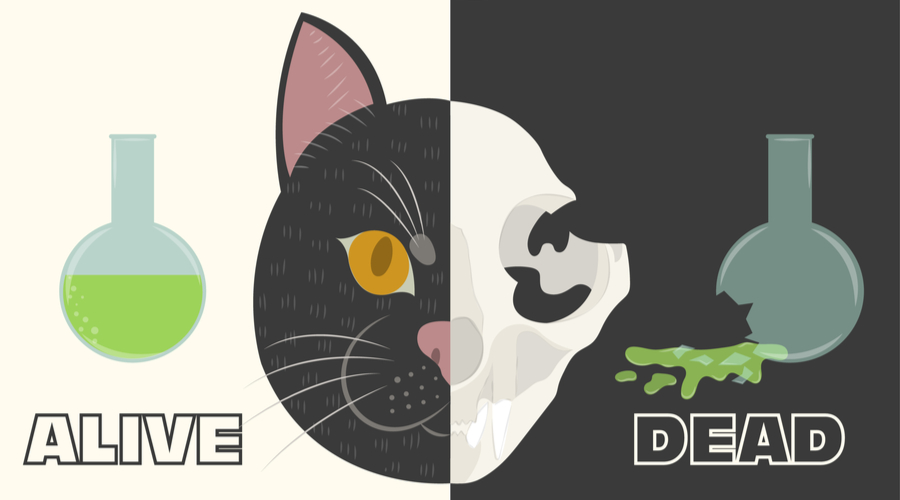Schrödinger’s Cat and the Mandela Effect
Although the title of this article sounds more like a 1960s prog-rock band than a theory, there is actually quite a lot of serious thought and intellect involved. Take a seat, settle back and let’s consider why a thought experiment by a prominent physicist, Erwin Schrödinger, could help us explain the Mandela Effect.
Who is Erwin Schrödinger?
Erwin Schrödinger was a Viennese physicist who was awarded the Nobel Prize in Physics in 1933 when he was 46 years old. In the second world war, he fled to the UK and was eventually based in Dublin. He was quite the colourful character and he is also known for having fathered an illegitimate child – which is hardly shocking now but was back then. He is best known for his detailed work in the field of quantum physics and that one famous experiment involving a cat.
Schrödinger challenged the Copenhagen Interpretation of quantum physics. This essentially states that an object in a physical system can simultaneously exist in all possible configurations. However, if you observe this flux the system collapses and forces the object into one possible state. Erwin Schrödinger said this was not the case.
The Cat Experiment
First, as we are on the internet and you don’t mess with cats on the internet, no animal was harmed in this experiment. It is a thought experiment. Therefore, the events we are about to explore should only happen in your imagination. It is a musing, let’s call it. It is like asking I wonder what will happen if the sun disappears. We can’t make that ball of gassy rock disappear to find out, so we have to run the experiment through in our minds to work out the potential consequences.
Here is the experiment to only do in your mind.
First, imagine a box with a lid. Now, place in that box a cat, some poison in a glass vessel, a Geiger counter, radioactive material, and a hammer. Then, seal the container. Now, the amount of radioactive material should only be enough to have a 50/50 chance of decaying and causing radioactivity and stirring the Geiger counter over the course of an hour. However, if the radiation were detected then the hammer would smash down, releasing the poison, which the cat might eat and therefore die.
Now, this all sounds barbaric and it would be if we carried out the experiment. However, the importance of it being a thought experiment is that if we opened the lid of the box to check then the experiment would be ruined. The act of observation would collapse the possibilities of alive, both alive and dead, and dead into one configuration. It is a sort of zombie cat. Until this time, all probabilities are possible. Consequently, the cat is both alive and dead at the same time. It is known as the Schrödinger Cat Paradox.
Now, this sounds a lot like he was suggesting that the Copenhagen Interpretation was correct. However, he was doing just the opposite – he thought it was a stupid idea. He wanted the idea to sound ridiculous. The Quantum superposition could not work with a large object like a cat – and it is impossible for an organism to be both alive and dead. He was using the experiment to highlight the flaw in what they were suggesting. The idea of all states being possible – the Quantum superposition – can only work for tiny things like electrons. He argued we needed to view the physical world differently – and just because we cannot do the mathematics, we cannot take the idea of Superposition too far and apply common sense.
So, although this was an exercise in proving something wrong – it also served to accept the original premise. He acknowledged that at the tiniest level all states were probable, so there were multiple states occurring at the same time.
What does this mean for the Mandela Effect?
This idea of a Quantum superposition does help us explain the Mandela Effect. It is an underlying principle of many universes’ theories. Therefore, at the smallest of scales, all possibilities are still available to us. Therefore, if we were to imagine thought and memory as part of this tiny world, then it is possible that traces of all theories are imprinted. This is a crazy supposition, we grant you. However, the key argument against the Mandela Effect is that you cannot see where there is seepage from one universe to another.
Ultimately, this means that we wouldn’t see it happening. The seepage, if it were to happen, is at the subatomic level. Not only does this mean that it is too small to see but if we could observe it there would be an immediate collapse into one state. So, on both accounts, we would not be able to observe it. Even if it were true of all things on Earth, as soon as looked it would cease. It is a bit like the weeping angels from Doctor Who in this way – you never see them moving – but when you blink!
Give it to me simply
Ok, so what happens at the big, every day normal level acts differently to what happens at the really, really small level. The cat was likely dead. It was in a sealed box. Get over it. Bottom line, it couldn’t be both. However, if it was a tiny, tiny electron, then it could be everything all at once (matter and energy – but now I am getting technical again).
This helps us because what we can see acts differently to what we can’t see. Therefore, it is completely possible in physics for something to be true and no one ever having seen it happen.

